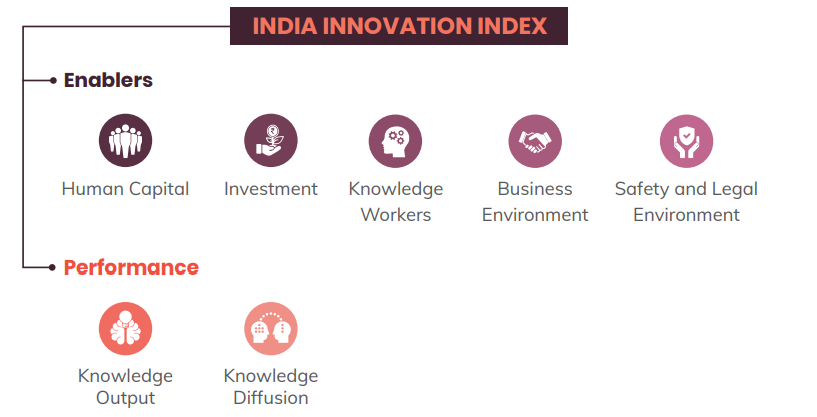Indian Economy
India Innovation Index 2021: NITI Aayog
- 22 Jul 2022
- 5 min read
For Prelims: NITI Aayog, India Innovation Index
For Mains: India Innovation Index, its Recommendations
Why in News?
Recently, India Innovation Index Report 2021 was released by NITI (National Institution for Transforming India) Aayog in which Karnataka retained its top position in the major States category.
- This is the third edition of the Report, which highlights the scope of innovation analysis in the country by drawing on the framework of the Global Innovation Index.
- The number of indicators has increased from 36 (in the India Innovation Index 2020) to 66 (in the India Innovation Index 2021).
What is the India Innovation Index?
- About:
- It is a comprehensive tool for the evaluation and development of the country’s innovation ecosystem.
- It ranks the states and the union territories on their innovation performance to build healthy competition amongst them.
- Institutions Involved:
- NITI Aayog with the Institute for Competitiveness.
- Indicators Used:
- There are 7 pillars in the index - five ‘Enabler’ pillars measure the inputs and two ‘Performance’ pillars measure the output.
- The indicators that the survey uses includes the level and quality of education and parameters such as:
- Number of PhD students and knowledge-intensive employment.
- Enrolment in engineering and technology and number of highly skilled professionals.
- Investment in R&D and number of patents and trademark applications filed.
- Internet subscribers.
- FDI inflows, business environment and safety and legal environment.
What are the Highlights of the Report?
- Categories:
- The Innovation Index is divided into three categories—major states, Union Territories, and hill and North East states.
- Major States:
- Top States: Karnataka topped with a score of 18.05 followed by Telangana and Haryana.
- Karnataka’s success is attributed to its peak performance in attracting FDI (Foreign Direct Investment) and a large number of venture capital deals.
- Bottom States: Bihar, Odisha and Chhattisgarh scored the lowest on the index, which put them at the bottom in the “major States” category.
- Chhattisgarh ranked last with 10.97 points.
- Top States: Karnataka topped with a score of 18.05 followed by Telangana and Haryana.
- Hill and North-East States:
- Manipur is leading the category followed by Uttarakhand and Meghalaya.
- Nagaland ranked last (10th).
- Manipur is leading the category followed by Uttarakhand and Meghalaya.
- Union territories/Small States:
- Chandigarh is the top performer with a Score 27.88 followed by Delhi and Andaman and Nicobar.
- Ladakh Ranked last (9th).
- Chandigarh is the top performer with a Score 27.88 followed by Delhi and Andaman and Nicobar.
- Challenges:
- On an average, the country has not performed well in the knowledge worker pillar, as much as it has in the human capital pillar.
- The expenditure on human capital has been unable to create that knowledge base in the country.
- Innovation is skewed against the manufacturing sector due to the problems pertaining to and the missing middle.
- Missing middle, i.e., there are too many tiny, informal enterprises, and too few large, formal ones to employ thousands of people.
What are the Recommendations?
- GDERD (Gross Domestic Expenditure on R&D) needs considerable improvement and should touch at least 2%, which would play an instrumental role in India achieving the goal of a 5 trillion economy and further influence its innovative footprint across the globe.
- Increasing GDERD promotes private sector participation in R&D and closing the gap between industry demand and what the country produces through its education systems.
- Countries that spend less on GDERD fail to retain their human capital in the long run and the ability to innovate is dependent on the quality of human capital; India’s GDERD as a percentage of GDP (Gross Domestic Product) stood at about 0.7%.
- The private sector needs to pick up pace in R&D, public expenditure is productive up to some extent; once the growth follows a trajectory, it is desirable to shift to R&D mostly driven by the private sector.





